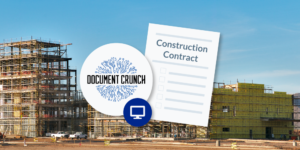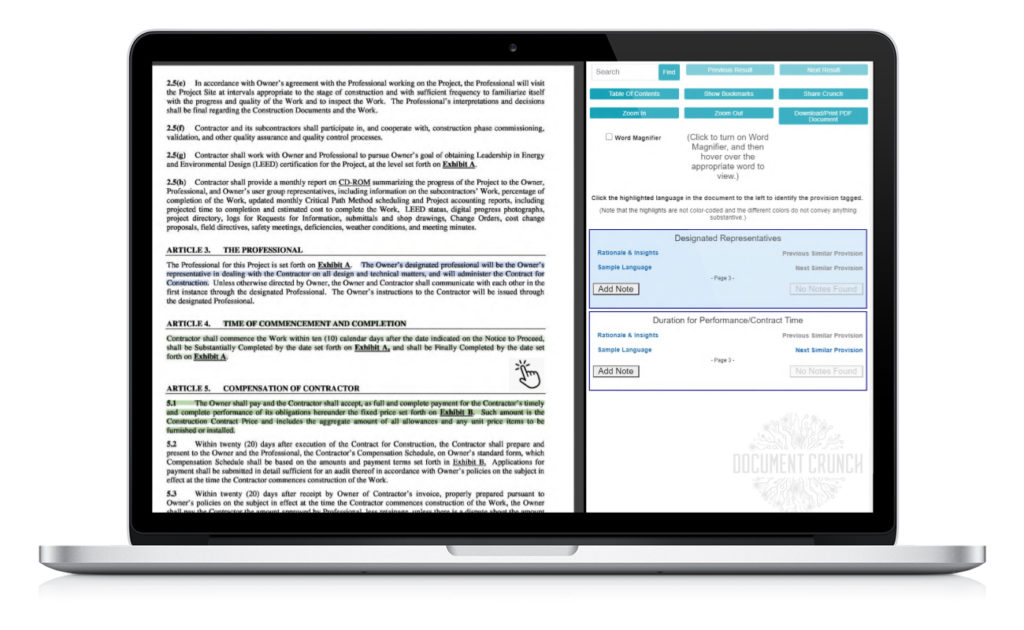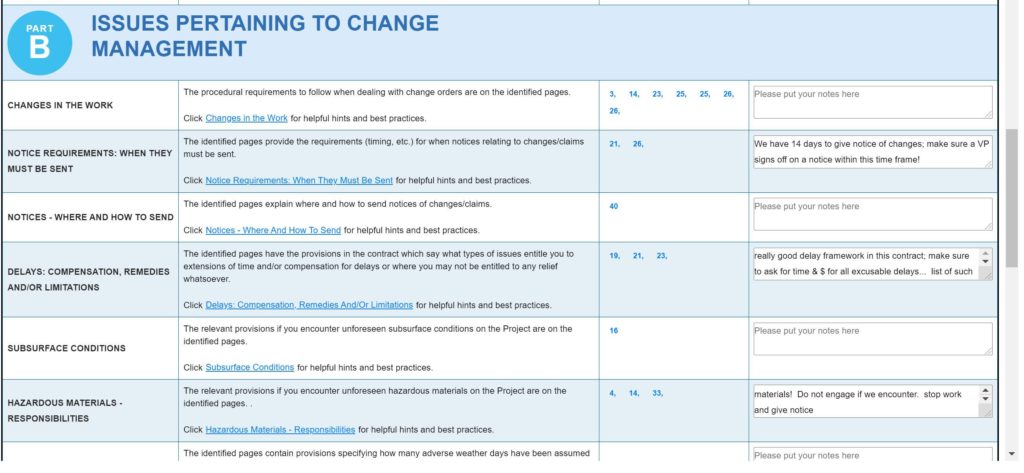
We don’t give the construction industry the credit it deserves when it comes to evolution. But very once in a while, new technology shows up and changes the way construction operates across the board. Document Crunch, an AI-powered contract review software purpose-built for the construction industry, aims to be one of those technologies.
If you aren’t familiar with Document Crunch yet, there’s a pretty good chance you will be in the future.I interviewed Document Crunch Founder and CEO Josh Levy to get some insight on this new technology. Keep reading to learn more about this service, how it works, and who benefits from it the most.
What is Document Crunch?
Construction contracts and documents can be very confusing, particularly for contractors who don’t have the time to learn the ins and outs of construction law and other critical business terms. As a result, many contractors are flying nearly blind, as they don’t understand the risk involved in their contracts.
Learn more: Construction Contract Documents | A Guide to Common Contract Parts
And even for those contractors who do have people who may understand these risks (like executives in the corporate office), project-level personnel need to understand contracts yet often struggle with this part of their job. Document Crunch’s program changes that.
When asked why Levy started Document Crunch in 2019, he made it clear that understanding risk was the driving force. “The risks still exist, but our industry has historically struggled to understand, manage, and administrate the risks in project documents,” Levy says. Document Crunch empowers customers to understand those risks, prepare for them, and make well-informed decisions.
On the surface, Document Crunch is an artificial intelligence-based construction document review software. A contractor representative uploads a document into the system. Within minutes, they receive a review focusing on more than 40 different provisions. This review breaks the contract down into easily digestible language. For example, it can explain contract price, waivers of consequential damages, subrogation waivers, indemnity, insurance obligations, and more.
In short, the software gobbles up a contract and spits out the critical provisions within, giving contractors an easily understandable reference.
But, Document Crunch isn’t just an algorithm. A team of curators and advisors provides insight and rationale, explaining and contextualizing the issues for the user. ensuring that the program is up to date and prepared at all times. The Document Crunch team doesn’t check the individual documents. But it does the necessary legwork, research, and updating to keep the machine on point. The platform is constantly learning and improving its awareness.
Document Crunch handles more than just contracts
Document Crunch’s focus is on construction contracts, but it handles more than just prime and subcontracts.
Among other documents, Document Crunch can analyze insurance documents, drawings, plans, specifications, non-disclosure agreements, leases, and other ancillary project documents.
“We’re really there as part of the builder’s toolbox for anything that impacts construction operations,” Levy says.
Beyond construction, the platform also has solutions for commercial real estate, general commercial documents, and corporate governance and compliance documents.
Construction Document Retention: Saving Documents Can Help Contractors Keep More Money
Who is Document Crunch for?
Document Crunch is a flexible and versatile tool, and nearly any construction company can benefit from it. But certain personnel might appreciate it even more than others.
Document Crunch is ideal for anybody who sits in the back office for a contractor or sub, and whose job is understanding, bidding, negotiating a contract, or reviewing a contractor for risk. So, anyone who could use that extra edge to ensure they truly understand a contract and what it entails.
Document Crunch is also ideal for “anybody at the project level who has to manage those agreements or documents day-to-day in order to run successful and profitable projects,” says Levy.
Document Crunch breaks these contracts down to highlight the finer points. This allows the “boots-on-the-ground” personnel to make smarter, more informed decisions. These folks can respond intelligently to changes in the work, delays, and other situations in project negotiations.

And, while Document Crunch is more than capable of handling the contracts of large GCs and construction companies, it’s also a smart move for smaller shops, such as a one or two-person subcontractor.
“In my experience, smaller subcontractors aren’t always able to use the most qualified person to put eyes on documents that a GC puts in front of them,” Levy says. “I have seen time and again such companies sign up for contracts without really understanding the deal.”
He went on to mention that, historically, hiring outside counsel is too expensive. So, they move forward with an unsettling feeling that they might not grasp every detail of the contract.
“That’s the problem we’re solving for them,” Levy says. “We believe this can really level the playing field for our industry so that even smaller companies, or less experienced individuals, can increase their acumen around these issues.”
The Document Crunch platform is evolving over time
Document Crunch went commercial in early 2020, so it’s still developing new features and expanding its offerings. Initially, it began by review construction contracts, but it’s since added additional products and focused on user experience.
One of the offerings that Levy was most excited about is the Project Team Cheat Sheet, which really breaks down the contract to the most need-to-know level as a quick reference for the people in hardhats on the day-to-day.

“Imagine a small subcontractor is being told, ‘You have to sign this contract or we’re going to move to the next guy,’” Levy says. “Now imagine the day that the same subcontractor says, ‘I understand that only 14 percent of my peers would sign this contract.’ Imagine being armed with that knowledge. It may change how you decide to proceed.”
Does Document Crunch provide human review?
When a representative of a construction company uploads a document into the Document Crunch system, artificial intelligence crawls it and pulls out the important provisions. But, which documents receive human review?
No documents receive human review through Document Crunch. In fact, Levy was sure to explain that Document Crunch is not a replacement for human review. Instead, it’s an augmentation for human review.
“I like to think of our tool as an MRI machine,” Levy explains. “You can very quickly get into core issues that you want to put your eyes on, and it’s a reinforcement for you to put eyes on it. But it’s still up to the doctor to make the prognosis, and that’s how we view this tool.” The idea is to highlight the important provisions and give the user the ability to engage and make an informed decision.
The platform also doesn’t provide any legal advice, nor does it provide a network of human professionals for referral. At this point, the platform has no desire to get into this side of contract or document review.
“We’re really trying to demystify the pain that goes into these voluminous, complex documents, to make it easy for everyone to understand.”
– Josh Levy, Document Crunch co-founder and CEO
Document Crunch is easy to understand
The ability to highlight important provisions doesn’t help if the language used is difficult to understand. Document Crunch uses easily digestible language to explain the provisions.
“The idea is that anybody on a construction project can understand how to use our product. We’re really trying to demystify the pain that goes into these voluminous, complex documents, to make it easy for everyone to understand and make good decisions based upon their understanding.”
Document Crunch allows users to leverage their contracts
Levy pointed out that there’s a misconception that Document Crunch is only about analyzing risk, but that there is much more to the platform. Levy believes the software really shines when it prevents day-to-day personnel from being taken advantage of due to a lack of fully understanding a contract and its troublesome clauses.
“Project teams don’t need to know about legal liability or jury trial waivers,” says Levy. “They need to know about who to give notice to when it rains. Or why rain should entitle them to schedule relief. I believe this is every single project every day, and Document Crunch needs to be used by people in the field. It’s about not letting entitlements slip through your fingers because you’re not fully administrating the contract and preserving that small fee that our industry is able to make.”
Document Crunch can improve user knowledge of contracts
As construction companies utilize Document Crunch, they’re also strengthening the savviness of their staff. As users continue to crunch documents, they’ll be learning about which provisions to look out for, why they should look out for them, and building on their own experience.
Levy described a scenario where many offices have one person who acts as the contract oracle in a back office, and they have all the answers. In many cases, that person becomes slogged down by questions and documents, and their ability to give important answers on the fly is seriously hampered.
With Document Crunch, Levy believes you can make oracles of your field personnel. They’ll learn how to understand a contract better, allowing them to make better decisions, build successful projects, and drive more profitable outcomes.